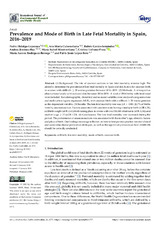Prevalence and Mode of Birth in Late Fetal Mortality in Spain, 2016–2019
Autor
Hidalgo Lopezosa, Pedro
Cubero-Luna, Ana María
García-Fernández, Rubén
Jiménez-Ruz, Andrea
Maestre-Luna, María Isabel
Liébana Presa, Cristina
Rodríguez Borrego, M.A.
López Soto, Pablo Jesús
Editor
MDPIFecha
2023Materia
StillbirthLate fetal mortality
Mode of birth
Cesarean birth
METS:
Mostrar el registro METSPREMIS:
Mostrar el registro PREMISMetadatos
Mostrar el registro completo del ítemResumen
Background: The rate of cesarean sections in late fetal mortality remains high. We aimed to determine the prevalence of late fetal mortality in Spain and risk factors for cesarean birth in women with stillbirth ≥ 28 weeks gestation between 2016–2019. (2) Methods: A retrospective observational study with national data between 2016–2019. A total of 3504 births with fetal dead were included. Sociodemographic, obstetrical and neonatal variables were analyzed using univariate and multivariate logistic regression (MLR), with cesarean birth with a stillborn ≥ 28 weeks gestation as the dependent variable. (3) Results: The late fetal mortality rate was 2.8 × 1000; 22.7% of births were by cesarean section. Factors associated with cesarean were having a multiple birth (aOR 6.78); stillbirth weight (aOR 2.41); birth taking place in towns with over 50,000 inhabitants (aOR 1.34); and mother’s age ≥ 35 (aOR 1.23). (4) Conclusions: The late fetal mortality rate increased during the period. The performance of cesarean sections was associated with the mother’s age, obstetric factors and place of birth. Our findings encourage reflection on how to best put into practice national clinical and socio-educational prevention strategies, as well as the approved protocols on how childbirth should be correctly conducted.

